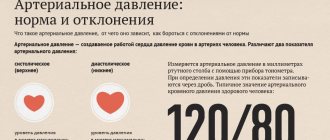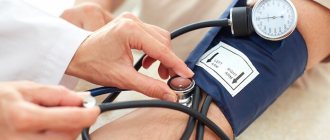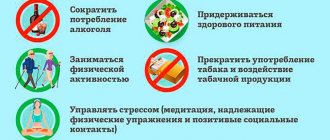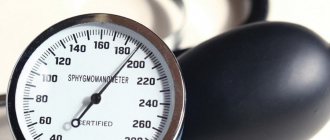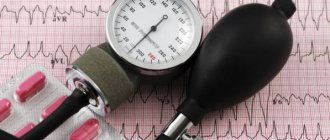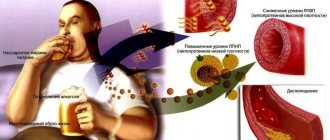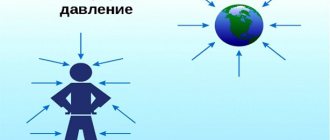Pressure is an integral indicator indicating a qualitative characteristic of human health. At its core, it represents the force with which the hematological fluid acts on the blood vessels.
Pressure usually refers to only one type of it - arterial. There are other types - capillary, venous. It is the first that reflects vital indicators and the degree of functional viability of the cardiovascular system as a whole.
The norm is determined by the range from 100 to 140 by 80-90. These are generally accepted indicators, which, however, do not always reflect the real state of affairs. Minor deviations are possible, both upward and downward, but they cannot be more than 5-10 mm Hg. Otherwise we are talking about pathology.
Pressure 100/50 mm Hg. Art. a priori cannot be considered normal, since the difference between systolic and diastolic readings is 50 mm Hg. Art. (norm 40).
This is a direct indication of pathology or a physiological factor. What kind - you need to find out with your doctor. What should you know about isolated hypotension?
Is the normal pressure 100 to 50 mmHg?
No, as already mentioned, such pressure is not normal. The causes of isolated diastolic hypotension are always pathological, with a number of exceptions (which are relatively rare).
In what cases can we talk about an isolated type of arterial hypotension of the diastolic type?
When considering the normality of this indicator and its physiology, several factors must be taken into account: the patient’s age, his general state of health, gender, professional status, occupation, physique and height, body weight.
For different ages
Thus, teenagers aged 15-19 years and the elderly are most susceptible to sudden changes in blood pressure.
Adolescence is associated with significant changes in hormonal levels (the so-called puberty or puberty). The concentration of testosterone in men and estrogen in women is increasing, but the levels of active substances are unstable. Hence the disturbance of hemodynamics, vascular tone and, as a result, the regulation of blood pressure.
Senile age is associated with generalized disorders in the functioning of the cardiovascular system. Often there is coronary heart disease, heart failure, which causes changes in the nature of blood ejection.
In addition, if we are talking about pediatric patients, hypotension in them is quite normal, even against the background of tachycardia (accelerated heart rate).
Paula
As practice shows, working blood pressure may be higher in women. However, their blood pressure levels vary by no more than 10 mmHg compared to men.
In addition, representatives of the fairer sex are more susceptible to changes in blood pressure levels. This is due to peak cyclic or age-related conditions: menstruation, menopause, pregnancy.
- During the menstrual cycle, the balance of specific active substances is disturbed, hypotension occurs, which partially causes poor health.
- Pregnancy. A pressure of 100 to 50 during pregnancy is possible with bradycardia (pulse less than 60 beats per minute) or tachycardia (more than 80 beats per minute). In this situation, it is completely normal and does not require treatment.
- Finally, menopause in any phase. This is a decline in reproductive function. Hormones again “jump”, this time their concentration drops, along with blood pressure.
- Menopause is not a purely female phenomenon. There is also a male menopause, and it is associated with a drop in the concentration of testosterone in the blood.
Physique
In obese patients, low blood pressure practically does not occur in physiological terms. There may be pathological factors causing the problem.
General health
In the presence of somatic diseases of organs and systems (diabetes mellitus, etc.), there is a high probability of developing hypotension or the opposite process - hypertension. Life history must be taken into account when assessing the performance of the cardiovascular system.
Professions and climate
Professional status and type of activity, as well as climatic conditions, explain the formation of special adaptive mechanisms of the human body.
A similar phenomenon occurs among metallurgists, workers in hot industries, and residents of hot climate zones (tropics, subtropics). Professional hypotension can also develop in athletes.
In most cases, isolated hypotension does not develop due to physiological factors. You need to look for a specific health problem.
Symptoms of hypotension
Low blood pressure, which slows the flow of blood, impairs cerebral circulation and causes the heart to work incorrectly, is accompanied by a number of symptoms that negatively affect the quality of life, including the following:
Blood pressure 120 over 55 - what does this mean?
- throbbing pain in the temples;
- feeling of heaviness in the chest;
- headache;
- dizziness, sometimes accompanied by loss of consciousness;
- attacks of nausea and vomiting;
- pale skin;
- increased sweating;
- dark spots before the eyes;
- tachycardia;
- bradycardia (slow heart rate);
- feeling of coldness in the extremities;
- strong weather sensitivity.
Chronic hypotension leads to memory impairment, decreased performance, drowsiness, inattention, frequent insomnia, and mood swings.
Important! Hypotension is especially dangerous during pregnancy. The disorder, often accompanied by an increase in heart rate to critical values (100 beats per minute), can provoke severe toxicosis, lead to dehydration, oxygen starvation of the fetus and even premature birth.
Causes of low blood pressure
Low blood pressure is caused by many pathological factors. In some cases, identifying the causes is not so easy.
Interesting:
Heart rate (pulse) is not taken into account during diagnosis, since the tonometer readings play the greatest role.
Endocrine system diseases
They are diverse in nature and are the most common cause of low blood pressure.
What kind of violations are we talking about:
- Pathological processes affecting the thyroid gland. This is hypothyroidism, first of all. That is, a decrease in the concentration of thyroid hormones in the bloodstream. Hence the characteristic symptoms of this condition, including low blood pressure.
- Disorders of the pituitary gland. Due to injuries to the third ventricle area, tumors (most often functional and non-functional adenomas). As a result of the disease, there is a disruption in the production of TSH, which stimulates the functioning of the thyroid gland. More serious violations are also possible.
- Changes in the functioning of the adrenal glands. This paired anatomical structure produces special active substances, including cortisol. It has a pronounced hypertensive effect. With the removal of the adrenal glands, operations for their resection, neoplastic processes (tumors), the formation of secondary Addison's disease, that is, cortisol deficiency, is possible. Hence hypotension and other delights of cortisol and corticosteroid deficiency.
- Pressure of 100 over 45, 100 over 50 is possible in pathological processes such as diabetes mellitus, when generalized damage to the whole body and the cardiovascular system in particular is observed.
Other diseases
- Pathologies associated with cerebrovascular insufficiency. A low blood pressure of 100 to 50 means that it is possible that we are talking about a violation of the regulation of vascular tone at a general level. This is observed with osteochondrosis of the cervical spine, vertebrobasilar insufficiency. A similar condition also appears in cases of recently developed ischemic or hemorrhagic stroke. In such a situation, you need to wait and monitor the patient; relapse of cerebral ischemia is possible. Treating diseases associated with impaired trophism of the central nervous system is not easy; an interdisciplinary approach is needed.
- Pathologies that are accompanied by the development of bleeding and anemic processes. Including classic iron deficiency anemia, stomach ulcers, tuberculosis, Crohn's disease and others. As a result of such a scenario, hemodynamic disturbances (the passage of blood through the vessels) occur, hence isolated diastolic hypotension. Variants are also possible.
- Pathological processes affecting the liver. The largest gland of the human body, the liver is considered its main biochemical laboratory. If its functioning is disrupted, the functioning of the brain is disrupted, including specific regulatory centers of cerebral structures. Hypotension in such a situation is possible with more serious figures, up to critical levels, in acute hepatonecrosis.
- Acute infectious diseases, intoxication. They disrupt hemodynamics and affect the regulatory centers of the brain, provoking secondary hypotension of any type.
- Allergic reaction, anaphylactic shock. In such a situation, the body tries to mobilize resources, a similar process is accompanied by a sharp drop in blood pressure.
Subjective factors are also possible: abuse of antihypertensive drugs, smoking, too much alcohol.
What to do for quick help
Considering the possibility of encountering a hypotensive attack, it is worth remembering a few rules:
- Unless there is an urgent need, the patient should not be given medications (unless the hypotension is chronic and the person knows very well what medications are prescribed).
- In case of severe condition (loss of consciousness, severe pallor, convulsions), you should immediately call an ambulance team.
- In case of significant hypotension, accompanied by certain clinical symptoms, the use of over-the-counter medications is allowed (Caffeine 1 tablet, Citramon 1 tablet).
Simple ways to help with mild hypotension:
- Lay the person down, raise the legs higher than the body.
- Thoroughly ventilate the room, loosen tight clothing on the victim.
- Brew strong tea with sugar and give it to the victim to drink.
- Advise the person to breathe slowly and deeply.
Possible consequences
Complications of hypotension, especially isolated ones, can be severe. These include:
- Sudden syncope or collaptoid states (fainting), which can take a person by surprise. Including in dangerous environments.
- Decrease in cognitive functions up to dementia. Develops during a long-term pathological process.
- Cardiac dysfunction and the formation of secondary pathologies of the cardiovascular system.
- Strokes. Usually ischemic (an acute cerebrovascular accident with the death of individual neurons and their bundles).
- Heart attacks. Usually associated with sudden increases in blood pressure.
- Coronary heart disease of congestive nature.
These conditions can only be prevented by consulting a doctor. The longer hypotension lasts, the higher the risks.
What do the indicators mean?
A normal pressure is 120 to 80 mm Hg. Art. If the readings are lower, this indicates a possible cardiac dysfunction.
For pregnant
For pregnant women, blood pressure readings of 110 to 50 are low and require specialist supervision to avoid possible pathologies in the development of the fetus.
For adults and seniors
If an adult or elderly person has a pressure of 110 per 50 mm Hg, this indicates a tendency to pathological hypotension, the cause of which is most often cardiovascular diseases.
For children and teenagers
For teenagers 12-15, this pressure may be normal. For children under 10 years of age, the upper figure is too high, since the norm is 80-90 per 50-60 mm Hg. Art. For very young children, the optimal values are 60-70 at 40-50 mm Hg. Art., which means that blood pressure 110/50 is too high for them.
What can you do at home?
Very small. Professional help from a doctor is required. In case of an acute attack of hypotension, you need to take a horizontal position, drink a tonic tablet (Citramon, aspirin), and eat a salty product.
It is important not to change body position too sharply; rapid movements are excluded. If the pressure continues to drop, you need to call an ambulance to resolve the issue of hospitalization or first aid.
You cannot take any medications on your own, other than those already mentioned, it is dangerous. It is unknown how the body will react. A sharp jump in blood pressure is possible, and in the case of insufficiently elastic vessels, a stroke.
Blood pressure 100/50 during pregnancy
Low blood pressure during pregnancy is not uncommon, but if a woman feels unwell and there is a rapid pulse against the background of hypotension, this is dangerous for both the expectant mother and the fetus.
If the pressure is 100 or below for a long time, this can lead to:
- to toxicosis;
- fetal hypoxia;
- dehydration of the body;
- miscarriage;
- premature birth.
Therefore, during pregnancy, you need to carefully monitor your blood pressure and, if there are persistent deviations from the norm, consult a doctor, even if you feel well.
Symptoms that require medical attention
List of warning signs:
- Blood pressure is 100/50 and a headache, especially intense, stabbing (we may be talking about a cerebral hemorrhage).
- Dizziness with darkening of the eyes.
- Fainting (actually syncope). Especially repetitive ones.
- General poor health, including weakness, drowsiness.
- Increase in body temperature to insignificant levels. Low-grade fever.
- Nausea.
- Vomiting, especially if it occurs several times.
Diagnostics: what tests need to be done?
Diagnostic measures that are indicated for suspected hypotension:
- Oral questioning of the patient regarding complaints.
- Collecting anamnesis, establishing the possible etiology of the process.
- Measuring blood pressure on both arms.
- Daily monitoring (measurement of pressure throughout the day).
- Determination of the level of thyroid and pituitary hormones, sex hormones in the bloodstream.
- Electrocardiography.
- Encephalography. Determination of functional brain activity.
There is enough of this research in the system.
How is hypotension treated?
The essence of treatment is to eliminate the root cause of hypotension, that is, the underlying disease that caused it. It is important to change your lifestyle, give up bad habits, optimize your diet (more spicy and salty foods) and your physical activity regimen.
Alcohol is also not the best companion for a patient with hypotension; it should be completely avoided.
- To increase the pressure itself, symptomatic use of caffeine-based tonics is necessary. These are drugs that directly increase cardiac blood output and arteriolar tone, which increases the tonometer readings to the desired level. Names: “Citramon”, “Askofen”, “Coffetamine”, “Ortho-taurine”, “Pyramein”, “Regulton”, “Saparal”. The maximum dose of caffeine per day for an adult is 0.1 g. Otherwise, tachycardia is possible (heartbeat acceleration to 90 or more beats per minute).
- From herbal tonics: tinctures of eleutherococcus, lemongrass, ginseng, aralia.
- To improve the supply of blood and oxygen to the brain, normalize memory and concentration, nootropic drugs are used. Among them: “Cavinton”, “Xanthinol nicotinate”, “Niceroglin”, “Nootropil”, “Picamilon”, “Tanakan”, “Phenibut”, “Cinnarizine”, “Encephabol”.
- Amino acids and proteins to support brain function: “Glycine”, “Citrulline”, “Cerebrolysis”. Vitamins A, E, B, to improve vascular tone in the body.
- To stimulate the nervous system with a persistent, prolonged fall in Hell, Midodrine or Gutron are prescribed.
The specific names of the drugs are selected only by the doctor, taking into account the diagnostic results and the individual characteristics of the body.
A blood pressure of 100/50 poses a health hazard. Complex treatment is required. Otherwise, complications should be expected.
Should low blood pressure be treated?
You can fight low blood pressure only by changing your lifestyle: balance your diet, remove stress, exercise, start walking more, walk in the fresh air, swim, take a massage course. Only if there is no effect from non-drug therapy, use medications on the recommendation of a doctor.
You need to start with adaptogen preparations of plant origin: Leuzea, Eleutherococcus, Ginkgo biloba, Schisandra. If these medicinal plants turn out to be ineffective, more serious medications are added: Mexidol, Actovegin, Cerebrolysin, Vinpocetine, which are taken intravenously in courses of at least two weeks.
Oral medications are prescribed as maintenance therapy: Mexidol, Mildronate, Cinnarizine, Cavinton. At night - sedatives: Novo-Passit, Persen, Afobazol, Glycine, Eltacin - a month.

